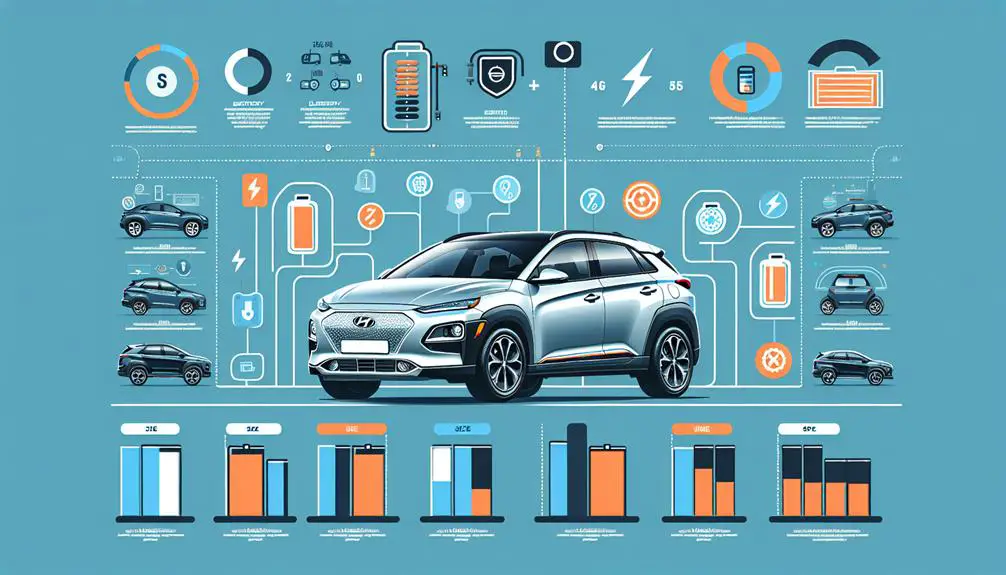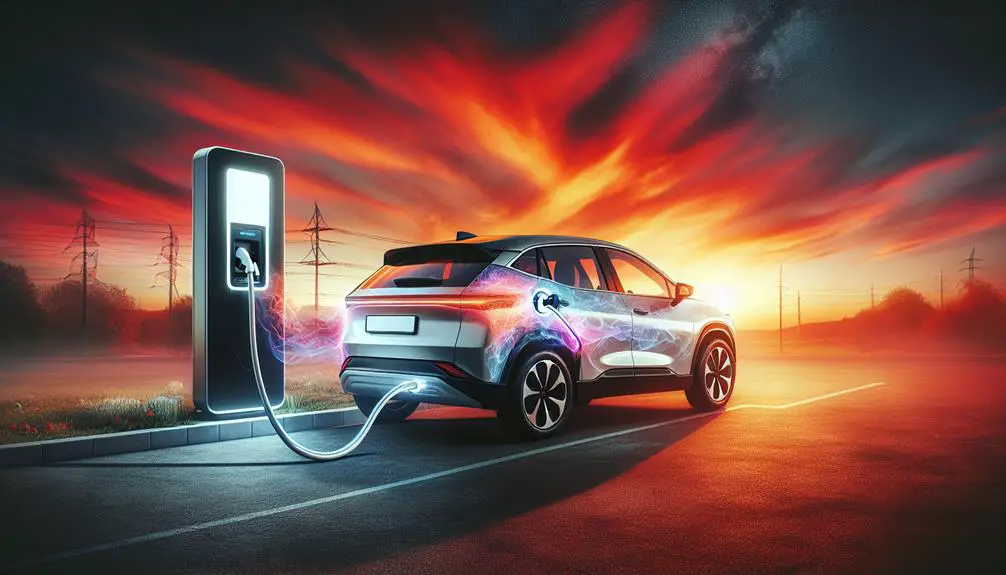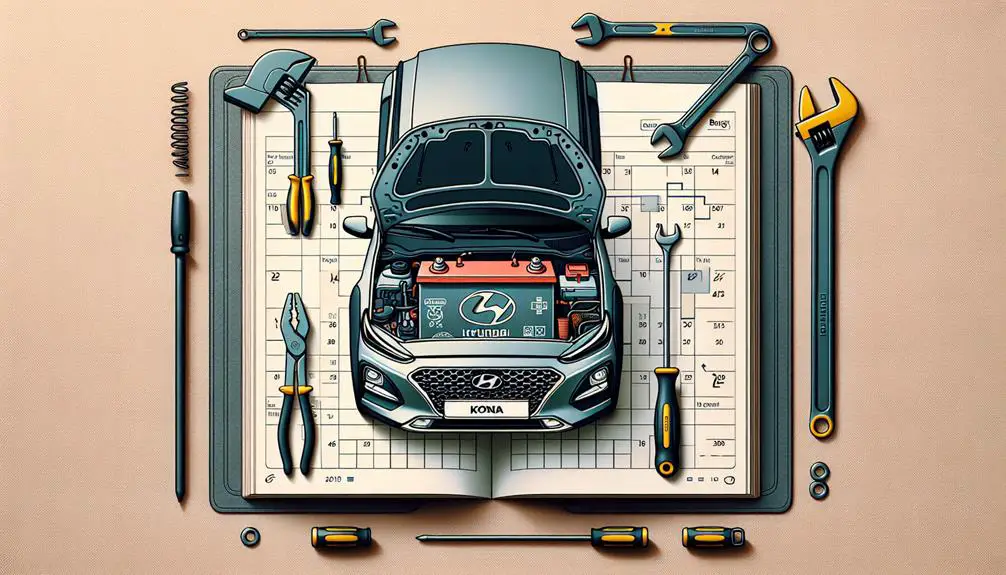The Hyundai Kona is available with different battery sizes depending on the model and year.
As the saying goes, knowledge is power, and when it comes to understanding the battery size of your Hyundai Kona, you're empowering yourself to make informed decisions about your vehicle.
Whether you're curious about the range, efficiency, or simply seeking maintenance tips, it's crucial to start with the basics.
By getting to grips with these variations, you'll unlock insights into how to optimize your Kona's longevity and efficiency.
So, why is knowing the exact battery size and its implications so vital for your electric vehicle experience? Let's explore.
Battery Capacity Explained

Battery capacity is important because it shows how far your Hyundai Kona can go on one charge. It's measured in kilowatt-hours (kWh), which tells us how much energy the battery can hold. Think of it as your electric vehicle's (EV) fuel tank; the bigger it is, the more energy it stores, letting you drive further without needing to recharge.
The battery capacity affects how well your Hyundai Kona works. It powers everything, including the motor and the air conditioning. If the capacity is higher, you don't need to recharge as often, which is better for long trips and reduces worry about running out of power.
But, it's not only about how big the battery is. How efficiently the Kona uses the energy matters too, but we'll talk about that another time. For now, just know that the kWh rating of the battery is important. It shows the possible range and power you have. However, the actual distance you can drive can change depending on how you drive, the roads, and other things.
Range and Efficiency Insights
Understanding battery capacity is important for your Hyundai Kona. Let's discuss range and efficiency, which are crucial for getting the most out of your electric vehicle (EV).
The range is how far you can go on one charge, affected by battery size and how well the vehicle uses energy. Efficiency shows how well your car turns electricity into movement, measured in miles per kWh. Higher efficiency means you can drive further on the same charge.
Consider these points about range and efficiency:
- Driving Habits: Fast acceleration and speeding lower your Kona's range. Drive smoothly and use regenerative braking to improve efficiency.
- Climate Conditions: Cold or hot weather can decrease battery performance. Cold weather requires more energy for heating, and hot weather needs more for cooling.
- Maintenance: Regular checks and maintenance, like tire alignments and ensuring tires are properly inflated, help avoid energy loss and increase efficiency.
Charging Times Uncovered

To keep your Hyundai Kona ready, it's important to know the charging times.
Using a standard home outlet (Level 1, 120V) is the slowest method, taking up to 24 hours for a full charge. It's good for overnight charging if you don't drive much every day.
Level 2 charging (240V) is faster, charging the car from empty to full in about 9 to 10 hours. This is good for daily use.
DC fast charging (DCFC) stations charge the car from 10% to 80% in about 47 minutes. Using DCFC often may shorten the battery's life.
Charging times can change based on the battery's condition, the charging station's power, and the weather. Cold weather can make charging take longer.
Model Variations and Batteries
The Hyundai Kona comes in different versions, each with a specific battery size for various driving needs. Knowing the battery details for each version helps you choose the best Kona for you. There are models for those who want more range, faster charging, or a mix of speed and efficiency.
- Standard Range Model: This is good for people who want an affordable electric vehicle (EV). It has a smaller battery, so it can't go as far, but it's still fine for daily use and short trips, especially in the city or if you can charge often.
- Long Range Model: This one has a bigger battery for people who drive more or like to go on long trips. It can go much farther on a single charge, reducing the need to stop and recharge.
- Performance Model: This version is for those who want more power. It has a strong battery and better motor for fast acceleration and good handling, but still keeps a good driving range.
When picking a Hyundai Kona, consider how you'll use it: for everyday short trips, long travels, or for fun, powerful drives. Each Kona model matches different needs.
Maintenance and Longevity Tips

To make your Hyundai Kona's battery last longer, follow these maintenance tips:
- Keep the Battery Clean: Dirt and corrosion can reduce battery life. Regularly check and clean the terminals with a mixture of water and baking soda.
- Avoid Short Trips: Short drives prevent the battery from fully charging, weakening it over time. If you often take short trips, consider using a battery charger to keep the charge level up.
- Annual Professional Check: Have a professional inspect your battery and charging system once a year to catch and fix any problems early.
- Keep Cool: Park in shady areas or a garage to prevent the battery from overheating.
- Secure Battery: Make sure the battery is tightly secured to avoid damage from vibrations.
By following these steps, your Hyundai Kona's battery will last longer and perform better.
| Tip | What to Do | When |
|---|---|---|
| Clean Battery | Clean terminals with water and baking soda mix. | As needed |
| Avoid Short Trips | Drive longer distances when possible. | Regularly |
| Professional Check | Get battery and charging system checked. | Annually |
| Keep Cool | Park in shade or garage. | In hot weather |
| Secure Battery | Make sure the battery is well secured. | Periodically |
Conclusion
You now know a lot about the Hyundai Kona's battery, including how big it's and how long it takes to charge.
Whether you choose an electric Kona or a regular one, it's important to know about the battery. Different Kona models have different battery sizes, and taking good care of your battery can help it last longer.
So, enjoy your drives knowing what powers your car.
